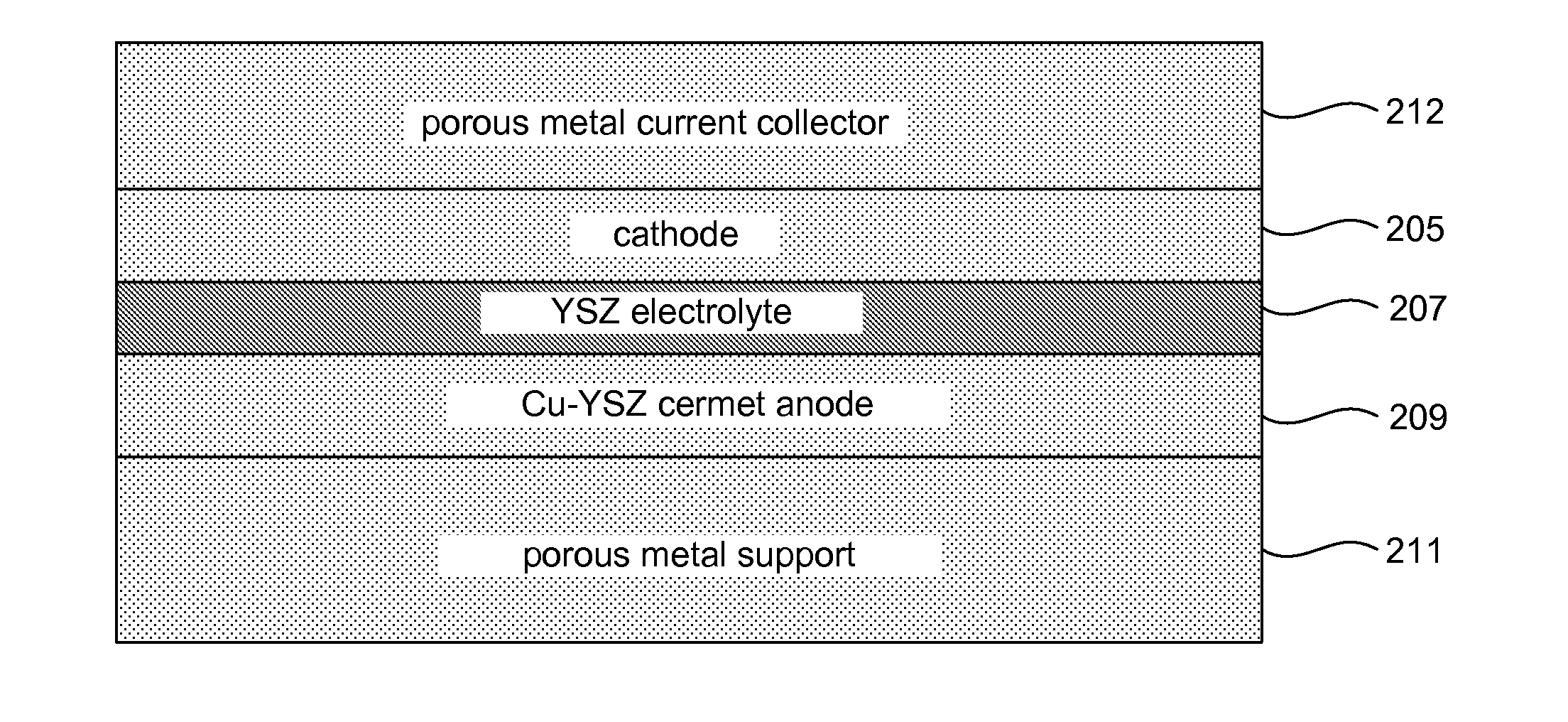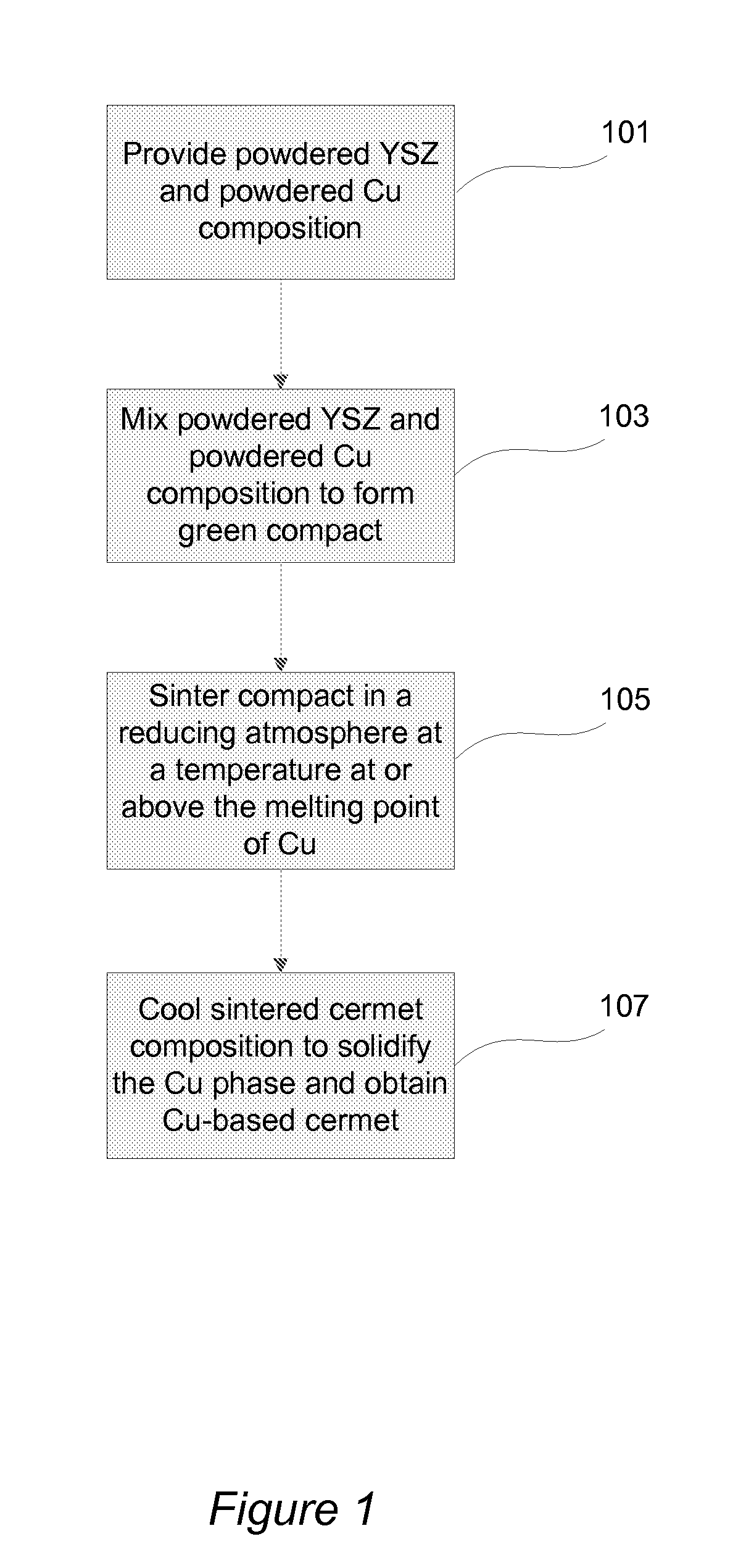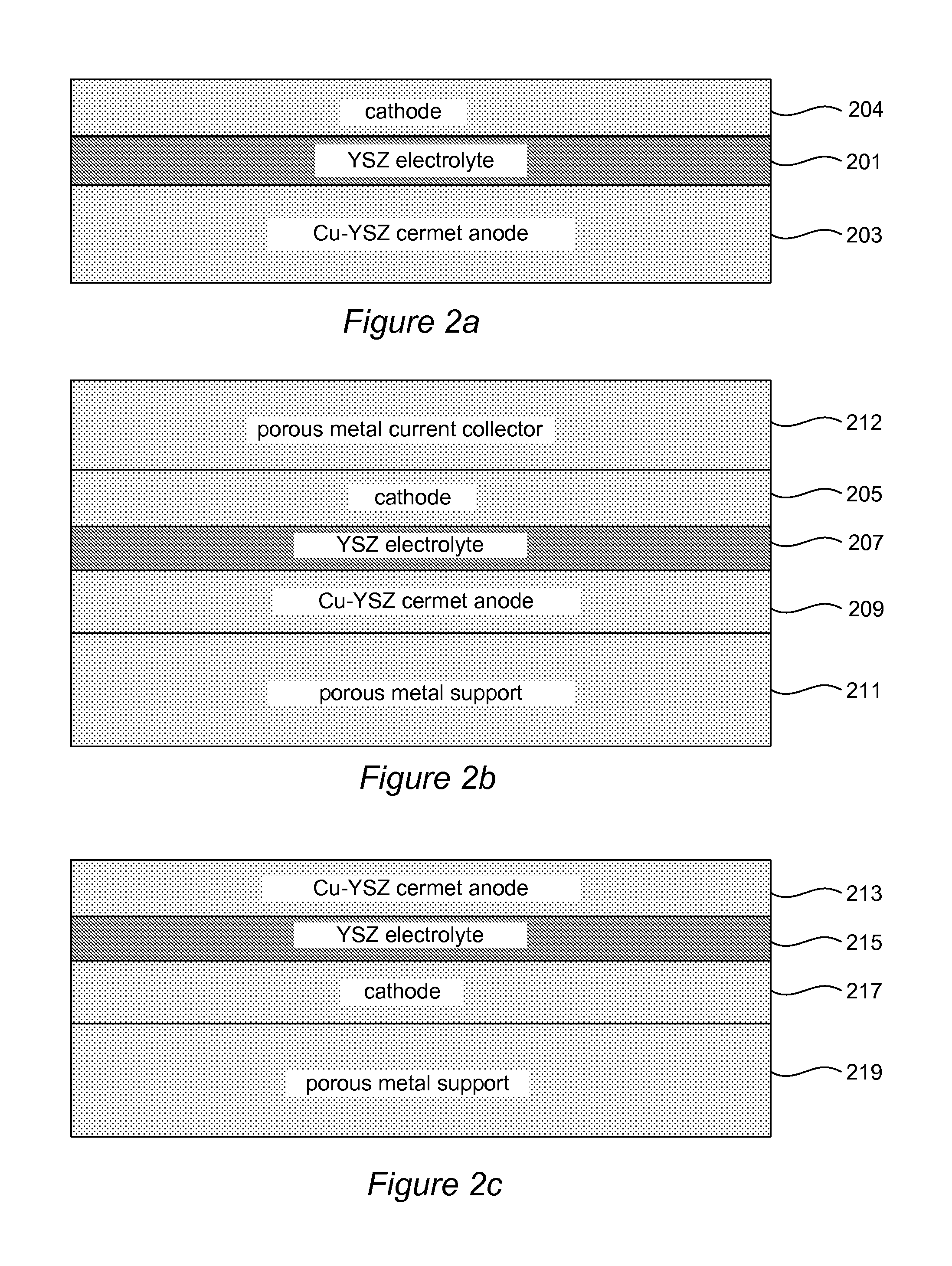Cu-based cermet for high-temperature fuel cell
a cermet and fuel cell technology, applied in the direction of cell components, final product manufacturing, sustainable manufacturing/processing, etc., can solve the problems of loss of contact between ceramic and metal, loss of interconnection in the metal network, etc., and achieve the effect of reducing interdiffusion
- Summary
- Abstract
- Description
- Claims
- Application Information
AI Technical Summary
Benefits of technology
Problems solved by technology
Method used
Image
Examples
example 1
Bonding of Cu Alloy to Yttria Stabilized Zirconia (YSZ) by Metal or Oxide Addition
[0063]Small amounts of oxides and / or metals were added to Cu or a Cu alloy. This was shown to improve the wetting and bonding to YSZ. Materials Used: 1-1.5 μm Cu powder, 3 μm Ni powder, ˜1 μm TiO2, 3-7 μm Mo metal.
Compositions“96Cu—4Ni”“94Cu—4Ni—2Cr”“94Cu—4Ni—2Ti”“94Cu—4—Ni—2Mo”0.96 g Cu0.94 g Cu0.94 g Cu0.94 g Cu0.04 g Ni0.04 g Ni0.04 g Ni0.04 g Ni0.02 g Cr2O30.02 g TiO20.02 g Mo (metal)
To each mixture an equal weight of a 2 wt % HPC (hydroxypropyl cellulose) in IPA solution was added to make a thick paste for mixing the powders together. A drop of each paste was put on a polished YSZ plate (˜3 cm diameter). The samples were then fired in a tube furnace with ˜60 sccm of flowing 4% H2 / He with the following heating schedule:[0064]8 hrs to 300° C.[0065]3 hrs 20 min to 1300° C. (5° C. / min)[0066]1 hr hold[0067]3 hrs 20 min to 25° C.
After firing all four samples were bonded to the YSZ disc with wetting impr...
example 2
Effect of alloy composition on wetting and Cr diffusion on ferritic steel
[0068]The effect of increasing the Ni content on the wetting and on Cr diffusion through the Cu alloy was examined. During sintering of a Cu alloy or cermet in contact with FeCr containing alloys Cr and / or Fe can diffuse out of the metal support and into the Cu alloy. This can result in oxidation of the fine Cr containing metal particles and then to cracking of the cermet during fuel cell operation. It is known that Cr has very low solubility in Cu, but how the amount of Ni affects the diffusion and solubility of Cr at high temperatures is not known. After firing the following compositions on a 430 SS sheet and then placing them in an atmosphere that is reducing to Ni and Cu but oxidizing to Cr(H2+3% H2O at 800° C. for 24 hrs) we found that Cu alloys containing ≧50 wt % Cu avoid Cr diffusion and subsequent oxidation. From our experimentation we have found that the following composition is suitable for firing wi...
example 3
YSZ / Cu Alloy Supported SOFC
[0073]In order to assess the utility of the YSZ / Cu alloy cermet structure as a backbone for anode catalysis, a thin-film-electrolyte cell was cosintered on YSZ / Cu alloy cermet. A disk of YSZ / Cu—Ni—Cr alloy was coated with a thin layer of YSZ electrolyte and cosintered in reducing atmosphere at 1300° C. The small additions of Ni and Cr improve wetting of the Cu on YSZ. After sintering, the YSZ / Cu alloy cermet was electronically conducting at room temperature. This structure was infiltrated with a small amount of RuCl3 which converts to Ru in fuel atmosphere. A sprayed LSCF cathode with Pt current collector was added for electrochemical testing.
Fabrication:
[0074]A mixture of 5 g 8Y YSZ (Tosoh Corp), 4.75 g Cu, 0.2 g Ni, 0.073 g Cr2O3 (all powder particle sizes 1.5 μm or less), 0.12 g PMMA (polymethylmethacrylate) poreformer (0.5-11 μm particle size), and 0.2 g HPC (hydroxypropylcellulose) was ball milled 24 h in IPA (isopropyl alcohol). The mixture was then ...
PUM
| Property | Measurement | Unit |
|---|---|---|
| melting point | aaaaa | aaaaa |
| temperature | aaaaa | aaaaa |
| temperature | aaaaa | aaaaa |
Abstract
Description
Claims
Application Information
 Login to View More
Login to View More - R&D
- Intellectual Property
- Life Sciences
- Materials
- Tech Scout
- Unparalleled Data Quality
- Higher Quality Content
- 60% Fewer Hallucinations
Browse by: Latest US Patents, China's latest patents, Technical Efficacy Thesaurus, Application Domain, Technology Topic, Popular Technical Reports.
© 2025 PatSnap. All rights reserved.Legal|Privacy policy|Modern Slavery Act Transparency Statement|Sitemap|About US| Contact US: help@patsnap.com



